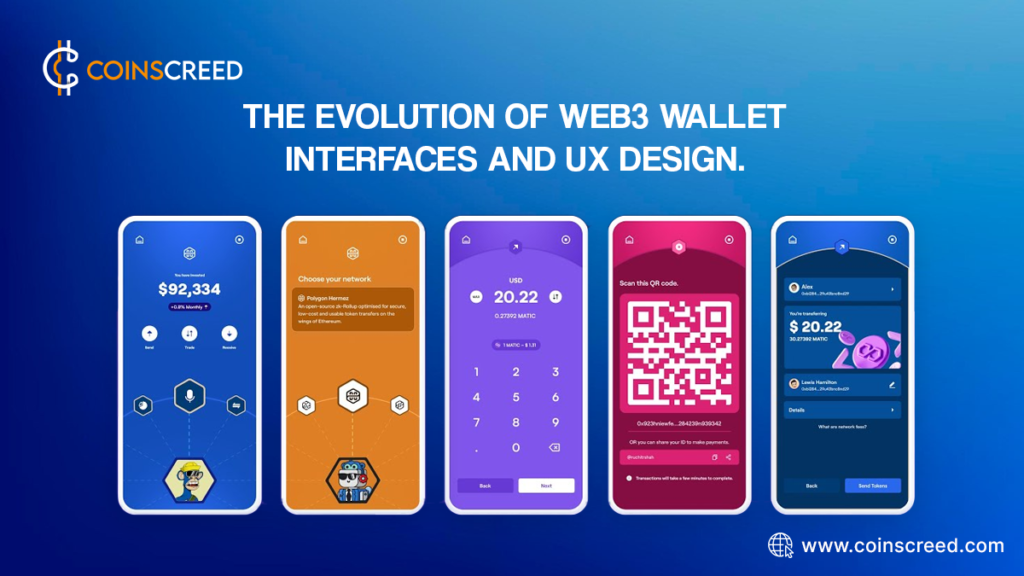In this article, we talk about Web3 wallet interfaces and UX designs, highlighting their evolution, importance, and future trends.

Web3 wallet design and usability have experienced notable evolution through the always-evolving field of cryptocurrencies and blockchain technologies. From the early days of clunky interfaces to the sleek and intuitive designs of today, the evolution of Web3 wallet interfaces and UX design reflects the growing maturity of the industry and the increasing emphasis on user experience.
Understanding Web3 Wallets
Web3 wallets, also referred to as decentralized wallets or crypto wallets, are digital tools that enable users to store, manage, and interact with cryptocurrencies and decentralized applications (DApps) on blockchain networks such as Ethereum, Binance Smart Chain, and Solana. Unlike traditional fiat wallets, Web3 wallets provide users with complete control over their funds, eliminating the need for intermediaries like banks or financial institutions.
Importance of Web3 Wallet Interfaces and UX Design
Web3 wallet interfaces and UX design are vital for several reasons:
Accessibility
A simply designed interface ensures that users can easily navigate and utilize Web3 wallets regardless of their technical expertise. Intuitive UX design lowers the barrier to entry for newcomers to the blockchain space, facilitating broader adoption.
Security
UX design can enhance security by guiding users through best practices such as secure key management and transaction verification. Clear indicators and prompts help users make informed decisions, reducing the risk of security breaches and asset losses.
Trust and Confidence
A polished interface instills confidence in users by providing a seamless and reliable experience. Transparent communication of wallet features, transaction status, and account management fosters trust between users and the wallet provider.
Interoperability
As the blockchain ecosystem expands, interoperability between networks and protocols becomes increasingly important. UX design can simplify interacting with diverse blockchain ecosystems, enabling users to navigate between decentralized applications and assets seamlessly.
Customization and Personalization
Web3 wallet interfaces should accommodate the diverse needs and preferences of users. Customizable features and personalized settings empower users to tailor their experience, enhancing usability and satisfaction.
User Education
UX design is an educational tool that guides users through complex concepts such as blockchain technology, cryptographic security, and decentralized finance (DeFi). Well-crafted interfaces provide informative prompts and explanations, empowering users to make informed decisions.
Early Web3 Wallet Interfaces and UX Design
When Web3 wallets first emerged, they often had a clunky and cumbersome interface that hindered user adoption. Most early wallets were designed primarily for crypto enthusiasts and developers, needing more user-friendly features that would appeal to mainstream users.
The interfaces were complex, with technical jargon and confusing navigation menus that made it challenging for novices to understand how to use them effectively. Here are some characteristics of early web3 wallets’ interface and UX design:
- Lack of User Guidance
- Limited Features
- Desktop-Centric
- Technical Jargon
- Security Emphasis
Lack of User Guidance
Early web3 wallets often needed more comprehensive user guidance or educational resources. Users had to rely on external sources or their research to understand how to use the wallet effectively and securely.
Limited Features
Early web3 wallets offered limited features compared to modern wallets. They focused primarily on sending and receiving transactions, with fewer options for managing assets, interacting with decentralized applications, or accessing decentralized finance (DeFi) protocols.
Desktop-Centric
Early web3 wallets were predominantly desktop applications or browser extensions with limited support for mobile devices—this limited accessibility for users who preferred managing their assets on smartphones or tablets.
Technical Jargon
Interfaces often featured technical terminology related to blockchain, such as private keys, public addresses, and transaction hashes, which made them less approachable for users unfamiliar with blockchain concepts.
Security Emphasis
Despite their technical nature, early web3 wallets strongly emphasized security. Users were often required to create and manage their private keys, with little support for recovery options in case of loss or theft.
Transition to User-Friendly Web3 Wallet Interfaces and UX Design
Recognizing the need for broader accessibility, developers began focusing on improving the UX design of Web3 wallets. The transition to user-friendly designs marked a pivotal moment in the evolution of blockchain technology, as it opened doors for a broader audience to explore and engage with cryptocurrencies and decentralized applications. Simplified interfaces, intuitive navigation, and clear instructions became hallmarks of this new wave of Web3 wallets.
Simplifying User Onboarding: Intuitive Design Principles
As the demand for user-friendly Web3 wallets grew, developers started incorporating intuitive design principles to simplify the onboarding process for new users. These wallets began to offer guided tutorials, tooltips, and interactive walkthroughs to help users familiarize themselves with the key features and functionalities.
By leveraging clean and minimalist design elements, Web3 wallets started to bridge the gap between complexity and accessibility, making it easier for users to manage their assets and interact with dApps.
Seamless Integration with DeFi Platforms
With increased decentralized finance (DeFi) platforms, Web3 wallets underwent further evolution to integrate seamlessly with various decentralized applications and protocols. Wallet providers started to offer built-in browser extensions that enabled users to access DeFi platforms directly through their wallets, eliminating the need for multiple logins and enhancing the user experience. This integration made it more convenient for users to participate in DeFi activities and enhanced the overall security of their digital assets.
Enhancing Security Features: Biometric Authentication and Multisig Support
Security has always been a top priority in the design of Web3 wallets, and as the technology advanced, wallet providers began implementing robust security features to protect users’ funds. Biometric authentication, like fingerprint and face recognition, became standard features in modern Web3 wallets, adding an extra layer of security to the login process.
Additionally, support for multi-signature (multisig) wallets gained popularity, allowing users to set up complex transaction authorization mechanisms, further safeguarding their assets from potential security threats.
Personalization and Customization Options
Web3 wallets began offering personalization and customization features so that users could adjust the wallet interfaces to their preferences. Users could now customize their dashboard layout, choose their preferred color schemes, and even rearrange the order of features based on their usage patterns. These personalization options enhanced the visual appeal of Web3 wallets and provided users with a more personalized and engaging experience.
Cross-platform compatibility and Mobile Accessibility
Recognizing the growing trend towards mobile usage, Web3 wallet developers focused on ensuring cross-platform compatibility and mobile accessibility for their products. Many wallets now offer mobile applications that provide a smooth and consistent user experience across different devices.
By optimizing their interfaces for mobile screens and touch interactions, Web3 wallets have made it simpler for users to manage their assets on the go, empowering them to stay connected to the blockchain ecosystem wherever they are.
Future Trends in Web3 wallet interfaces and UX design
The evolution of Web3 wallet interfaces and UX design is poised to continue rapidly, driven by innovations in blockchain technology and user feedback. Several noteworthy trends will likely significantly impact the future of Web3 wallets. These include the incorporation of augmented reality (AR) and virtual reality (VR) interfaces, the use of voice commands for navigation, and the integration of artificial intelligence (AI) to provide personalized user recommendations.
As the blockchain ecosystem evolves, Web3 wallets will play an instrumental role in democratizing access to decentralized applications and fostering mainstream adoption of blockchain technology.
Conclusion
The evolution of Web3 wallet interfaces and UX design reflects the ongoing efforts to make blockchain technology more accessible, intuitive, and secure for users worldwide. By prioritizing user experience, simplifying complex processes, and embracing innovation, Web3 wallets have transformed from clunky tools for crypto enthusiasts to user-friendly gateways to the decentralized future.
As we continue to witness advancements in this space, the future of Web3 wallets holds immense potential to change how we interact with digital assets and decentralized applications, paving the way for a more inclusive and decentralized financial ecosystem.
